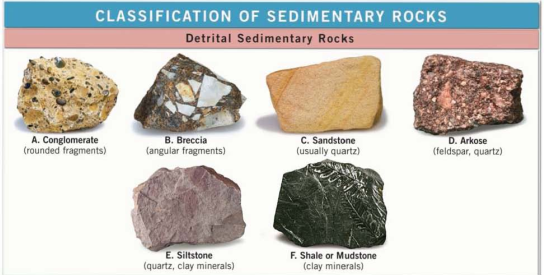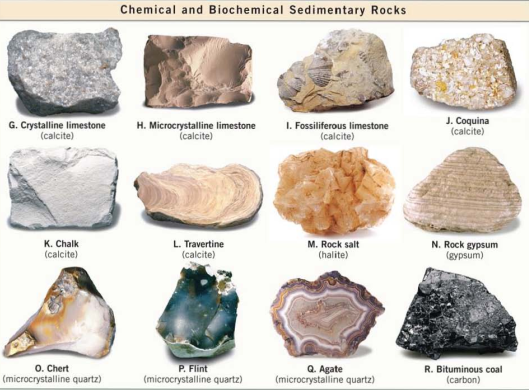
Applications and Investigations in Earth Science (9th Edition)
9th Edition
ISBN: 9780134746241
Author: Edward J. Tarbuck, Frederick K. Lutgens, Dennis G. Tasa
Publisher: PEARSON
expand_more
expand_more
format_list_bulleted
Textbook Question
Chapter 2.5, Problem 5A
Carefully examine the common sedimentary rocks shown In Figure 2.13. Use these photos and the preceding discussion to answer the following questions.


5. Compare and contrast Sample I (fossiliferous limestone) and Sample J (coquina ).
Expert Solution & Answer
Learn your wayIncludes step-by-step video

schedule00:50
Students have asked these similar questions
Please describe a scenario that could lead to more water being stored on the continents at the expense of water stored in the ocean
1. Complete the block diagram in Figure 6.20 by drawing a left-lateral fault on Part B.
2. Draw arrows on both sides of the fault in Figure 6.20B to illustrate the relative motion of each block.
On each of the block diagrams in Figure 6.16, determine the relative ages of the surface rocks on both sides of the fault trace (after erosion) and write the word older or younger on the appropriate side of each fault trace.
Chapter 2 Solutions
Applications and Investigations in Earth Science (9th Edition)
Ch. 2.1 - Label the rock cycle diagram In Figure 2.3 Figure...Ch. 2.1 - What is magma? How does magma differ from lava?Ch. 2.1 - The terms intrusive and extrusive are used to...Ch. 2.1 - In your own words, write a definition of rock...Ch. 2.1 - Name the process by which sediment is transformed...Ch. 2.1 - What is the most characteristic feature of...Ch. 2.1 - What type of rock is generated when rocks that...Ch. 2.1 - When determining rock composition, describe the...Ch. 2.2 - Which samples A- H exhibits porphyritic texture?Ch. 2.2 - For the samples you listed in Question 1, whal...
Ch. 2.2 - Which samples in Figure 2.9 exhibits...Ch. 2.2 - Complete the description of the environment which...Ch. 2.2 - Which samples in Figure 2.9 exhibits fine-grained...Ch. 2.2 - Complete the description of the environment which...Ch. 2.2 - Which samples in Figure 2.9 exhibits vesicular...Ch. 2.2 - Which samples in Figure 2.9 exhibits glassy...Ch. 2.2 - Although Samples A and C In Figure 2.9 appear...Ch. 2.3 - Use the color Index shown at the bottom of Figure...Ch. 2.3 - Use the color Index shown at the bottom of Figure...Ch. 2.3 - Use the color Index shown at the bottom of Figure...Ch. 2.4 - Place each of the igneous rocks supplied by your...Ch. 2.5 - Carefully examine the common sedimentary rocks...Ch. 2.5 - Carefully examine the common sedimentary rocks...Ch. 2.5 - Carefully examine the common sedimentary rocks...Ch. 2.5 - Carefully examine the common sedimentary rocks...Ch. 2.5 - Carefully examine the common sedimentary rocks...Ch. 2.5 - Carefully examine the common sedimentary rocks...Ch. 2.5 - Carefully examine the common sedimentary rocks...Ch. 2.5 - Carefully examine the common sedimentary rocks...Ch. 2.5 - Carefully examine the common sedimentary rocks...Ch. 2.5 - What mineral does Sample D contain that gives it a...Ch. 2.6 - Prob. 1ACh. 2.7 - Use Figure 2.16 to identify the environments A- L...Ch. 2.7 - Briefly describe the environment that is...Ch. 2.7 - The rocks in Zion National Park, Utah, consist of...Ch. 2 - The rock samples you encountered while completing...Ch. 2 - Match each of the metamorphic rocks listed below...Ch. 2 - Match each term or characteristics with the...Ch. 2 - Identify the folliated metamorphic rocks shown In...Ch. 2 - Identify each of the rocks shown in Figure 2.26...
Additional Science Textbook Solutions
Find more solutions based on key concepts
4. What five specific threats to biodiversity are described in this chapter? Provide an example of each.
Biology: Life on Earth (11th Edition)
Match each of the following items with all the terms it applies to:
Human Physiology: An Integrated Approach (8th Edition)
19. A diffraction grating with 600 lines/mm is illuminated with light of wavelength 500 nm. A very wide viewing...
College Physics: A Strategic Approach (3rd Edition)
Which of the following factors would tend to increase membrane fluidity? A. a greater proportion of unsaturated...
Campbell Biology in Focus (2nd Edition)
APPLY 1.2 Express the following quantities in scientific notation
using fundamental SI units of mass and lengt...
Chemistry (7th Edition)
19. Feather color in parakeets is produced by the blending of pigments produced from two biosynthetic pathways ...
Genetic Analysis: An Integrated Approach (3rd Edition)
Knowledge Booster
Similar questions
- Complete Figure 6.18 by illustrating an eroded reverse fault on Part B. Place arrows on both sides of the fault to illustrate relative motion.arrow_forwardPrompt: Using a visual art medium of your choice, please describe or explore any environmental issue or topic of your choice. Please ensure 100% human donearrow_forwardPrompt: Using a visual art medium of your choice, please describe or explore any environmental issue or topic of your choice. Please ensure 100% human donearrow_forward
- Prompt: Using an online art style of your choice, please make a meme related to the study of Geography, Environment, or Geomatics. Please ensure 100% human donearrow_forwardUsing a visual art medium of your choice, please describe or explore any environmental issue or topic of your choice.arrow_forwardUsing an online art style of your choice, please make a meme related to the study of Geography, Environment, or Geomatics.arrow_forward
- identify the 2 rocks in the photoarrow_forwardDraw several strike-dip symbols on Figure 6.14 that would be appropriate for a dome and a basin, respectively.arrow_forwardChoose two vehicles to compare. One being a gas powered one being electric. No hybrids. With the media of your choosing compare and contrast the two vehicles emissions and pollution factors. Key words are Hydrocarbon, Carbon, Hydrogen, Asthma, Infection, Pollution, and Global warming.arrow_forward
- Evaluate the advantages and disadvantages of gas and electric cars.arrow_forwardcharles darwin, what did he doarrow_forwardWhile Chapters 8 and 9 consider almost purely endogenic processes, Chapter 10 takes us further out from the center of the Earth to exogenic processes. My sister and I were out for a walk when we decided to cut through the cemetery. I could not help but wonder why the tombstones below are so different. While both tombstones are roughly the same age, the top one is made out of limestone while the bottom one is made out of granite. However, the one above looks much older due to a difference in the rate of weathering. Limestone is made out of the mineral calcite, CaCO3, calcium carbonate. Reads "1884" Dieds JOSEPH HERRING 1842-1911 JULIA HERRING 1843 NELLIE HERRING 1870-1882 Reads "1882" The tombstone in better condition here is made out of granite. Granite contains minerals such as quartz and feldspar. Both tombstones experience the same climate conditions and have been exposed to exogenic processes for the same amount of time yet they look so different! Some research into Chapter 10…arrow_forward
arrow_back_ios
SEE MORE QUESTIONS
arrow_forward_ios
Recommended textbooks for you
 Applications and Investigations in Earth Science ...Earth ScienceISBN:9780134746241Author:Edward J. Tarbuck, Frederick K. Lutgens, Dennis G. TasaPublisher:PEARSON
Applications and Investigations in Earth Science ...Earth ScienceISBN:9780134746241Author:Edward J. Tarbuck, Frederick K. Lutgens, Dennis G. TasaPublisher:PEARSON Exercises for Weather & Climate (9th Edition)Earth ScienceISBN:9780134041360Author:Greg CarbonePublisher:PEARSON
Exercises for Weather & Climate (9th Edition)Earth ScienceISBN:9780134041360Author:Greg CarbonePublisher:PEARSON Environmental ScienceEarth ScienceISBN:9781260153125Author:William P Cunningham Prof., Mary Ann Cunningham ProfessorPublisher:McGraw-Hill Education
Environmental ScienceEarth ScienceISBN:9781260153125Author:William P Cunningham Prof., Mary Ann Cunningham ProfessorPublisher:McGraw-Hill Education Earth Science (15th Edition)Earth ScienceISBN:9780134543536Author:Edward J. Tarbuck, Frederick K. Lutgens, Dennis G. TasaPublisher:PEARSON
Earth Science (15th Edition)Earth ScienceISBN:9780134543536Author:Edward J. Tarbuck, Frederick K. Lutgens, Dennis G. TasaPublisher:PEARSON Environmental Science (MindTap Course List)Earth ScienceISBN:9781337569613Author:G. Tyler Miller, Scott SpoolmanPublisher:Cengage Learning
Environmental Science (MindTap Course List)Earth ScienceISBN:9781337569613Author:G. Tyler Miller, Scott SpoolmanPublisher:Cengage Learning Physical GeologyEarth ScienceISBN:9781259916823Author:Plummer, Charles C., CARLSON, Diane H., Hammersley, LisaPublisher:Mcgraw-hill Education,
Physical GeologyEarth ScienceISBN:9781259916823Author:Plummer, Charles C., CARLSON, Diane H., Hammersley, LisaPublisher:Mcgraw-hill Education,

Applications and Investigations in Earth Science ...
Earth Science
ISBN:9780134746241
Author:Edward J. Tarbuck, Frederick K. Lutgens, Dennis G. Tasa
Publisher:PEARSON

Exercises for Weather & Climate (9th Edition)
Earth Science
ISBN:9780134041360
Author:Greg Carbone
Publisher:PEARSON

Environmental Science
Earth Science
ISBN:9781260153125
Author:William P Cunningham Prof., Mary Ann Cunningham Professor
Publisher:McGraw-Hill Education

Earth Science (15th Edition)
Earth Science
ISBN:9780134543536
Author:Edward J. Tarbuck, Frederick K. Lutgens, Dennis G. Tasa
Publisher:PEARSON

Environmental Science (MindTap Course List)
Earth Science
ISBN:9781337569613
Author:G. Tyler Miller, Scott Spoolman
Publisher:Cengage Learning

Physical Geology
Earth Science
ISBN:9781259916823
Author:Plummer, Charles C., CARLSON, Diane H., Hammersley, Lisa
Publisher:Mcgraw-hill Education,